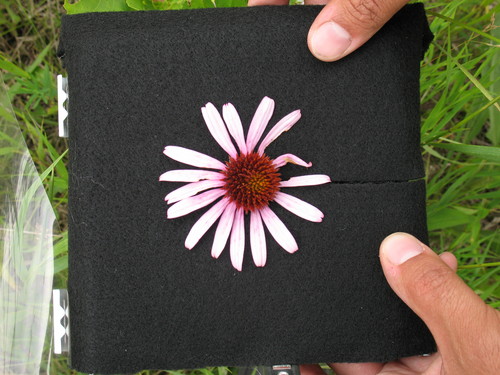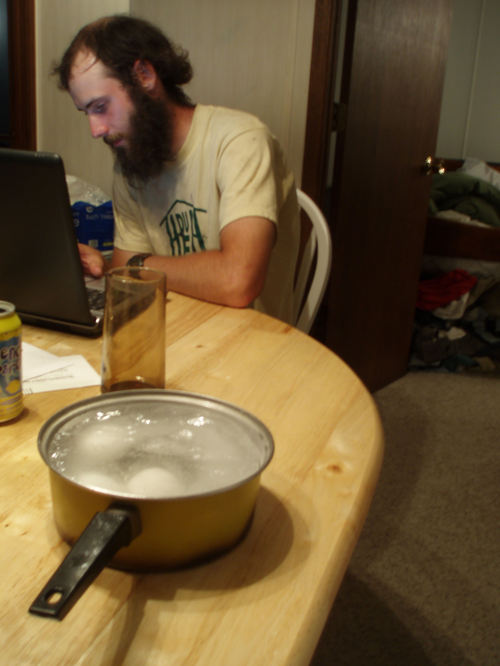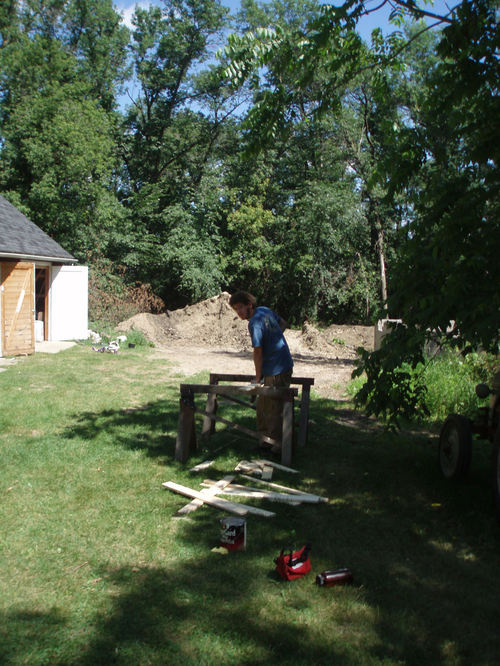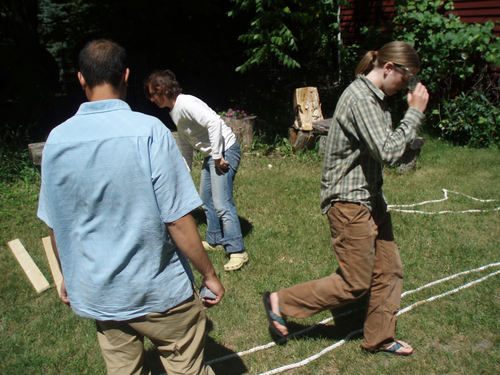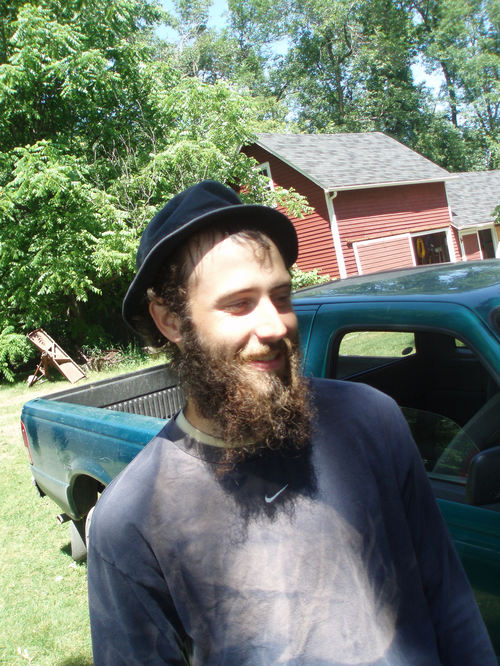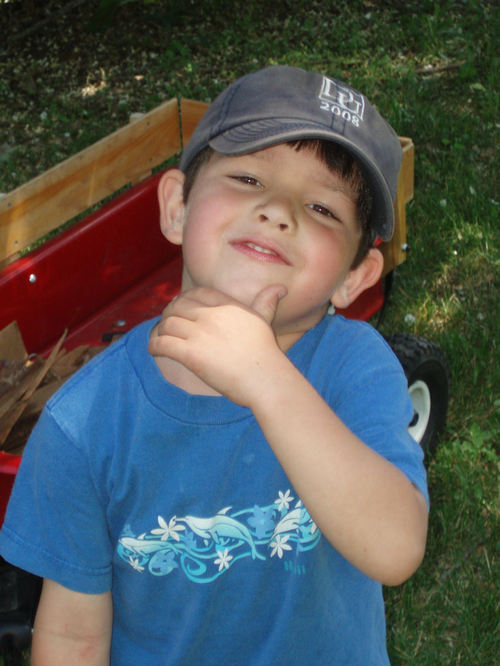|
|
A redesign of the original asymmetry contraption has finally reached (hopefully) it’s perfected state. With a black felt backing I was able to take several test pictures in the ’99 Garden South with the assistance of Dr. Andrew McCall.
One of these pictures was this beauty:

Later work with ImageJ allowed me to create a simplified version of the picture, with only the ray florets visible.
It looked something like this:

From this I was easily (with the help of a few lovely plug-ins), able to measure the areas of each ray floret. Thus, a measure of asymmetry is born!
On a note less related to Echinacea, I have realized that I haven’t loaded very many of my own pictures from this adventure. I then remembered that I hadn’t taken very many pictures, so in a frantic effort to catch up, I took a ton on a single day of work. So without further ado, I present to you the best of the pictures I have taken so far.
A Man and his Eggs.

Place of Work.

Man at Work.

Additional Folks at Work.

Jameson stole Per’s Hat…

…So Per stole Jameson’s Hat.

That’s all for now, I’ll get some more later. Maybe…
We have finished two weeks of the summer field season and I feel like we haven’t settled into a routine because we have been doing something new and different each day. It’s exciting.
Here’s a recap of accomplishments this past week…
Last week we finished searching for plants in the recruitment experiment. One plant (of ~1000 still alive) is flowering this year; it’s the first plant in the experiment to flower! The plant germinated in spring 2001.
Our high tech endeavors are underway and we have computer infrastructure to support them. Josh has networked the computers, hard drives, and printer. After some anxiety-inducing modifications to the video camera power supplies, we started taking video of pollinators & other visitors of Echinacea heads. Andy previewed a video this morning and it looks great! We still need to get more reliable power sources, but video cameras sure beat sitting on a bucket.
Colin has developed a camera rig to take shots of Echinacea heads in the common garden. We will be able to quantify many aspects of radial symmetry in the heads with the resulting digital images.
We assessed herbivory of ray florets in the common garden. We also looked at damage to disc florets. Jameson began to classify types of damage, but there weren’t that many heads with damage to the disk florets.
The KAP team (Julie, Rachel, and Josh) has made progress. Wind conditions have kept the kites on the ground most days, but they are making ground markers and have prepared the camera and rig. I flew the Sutton FlowForm 16 today in 12-16 mph surface winds at the park in Hoffman. Wow, it can pull. Yesterday, Gretel & I flew the G-Kites Dopero in somewhat variable winds. It was nervewracking.
The Bee team (Amy, Ian, Jameson, & Gretel) has abandoned my (bad) idea of watching bees through binoculars in favor of their much better idea. They are marking Agapostemon virescens individuals with acrylic paint and watching them when they are on the heads. They marked two bees on Friday and saw one on Saturday. Cool. They also have a slick form for entering observations.
We all have been making systematic observations of flowering phenology and style persistence of all plants in the common garden and along a transect at Staffanson Prairie Preserve.
In case anyone was wondering about the ostensibly narcissistic streak in recent posts, I _asked_ everyone on the team to post a profile with a photo.
Good work team Echinacea! We are making great progress in our quest to gain greater understanding of the ecology and evolution of plants and insects in fragmented prairie habitat.
With a contraption built to take accurate pictures of flowering Echinacea heads, I assumed that fluctuating asymmetry (FA) measurements were just around the corner. Boy howdy was I wrong. It turns out, as Stuart has informed me, there are many ways in which to measure FA, each as viable as the next. The most apparent idea, though potentially most flawed, was to simply measure the length of each ray floret and compare that to its complementary floret directly across the disk. Measuring 2 pairs of florets per head seemed simple enough, though it was soon found that there are many problems with such a simple procedure. For example, this idea doesn’t take into account any herbivory/senescence that has occurred, though most methods don’t. Also, any difference in widths between the florets was ignored. This plan obviously had to go. The quick fix solution to this was to measure the width of each floret as well, and compare these numbers separately. This again causes problems, since it doesn’t take into account the varying shapes of individual florets, but rather the similarity of a total area. The florets can have a similar area and yet certainly be very much asymmetric.
The ultimate solution to these problems is to measure asymmetry with an all encompassing measurement rather than one that attempts to isolate single florets. Stuart suggested creating 2 circles of best fit; one around the ray florets and one of the disk itself (either the outer edge or the flowering anthers, both may present their own difficulties). These circles would each have its own center point, the disk circle would represent the “true” center of the head, while the ray center point would be altered by any asymmetry of the florets. The ray floret center point would be calculated based on the area of color, therefore taking into account the area of the floret without making any assumptions as to the shapes of individual florets. The difference between these two points would give a numeric value of asymmetry. It seems to be the best solution so far, but I’m open to any other suggestions. This plan, like the rest, definitely has its own problems.
In non-Echinacea related news, the chiggers continue to molest my legs, but have also (oh, so fortunately) moved onto the rest of my body. I now have a collection of bites that range from that spot between my shoulder blades that I can never reach, to inside my belly button, to the tops of my feet. Sure glad those suckers are small enough so I can’t see them sneak into all of my clothing, yet large enough to cause so much damage. I’ll keep you posted on how my itching develops.
Dear flogophiles:
I’m trying to devise ways of measuring FA (see previous post) on our plants. Ideally, we would want measurements on several different organs or parts because if, for example, inbred plants are more developmentally unstable, it would be more convincing if they were more asymmetric in both leaves and inflorescences.
Colin is designing (and hopefully testing) the picture-taking rig for flowering heads. But, I think that it can also be used to take pics of leaves. The trick is getting the leaf to lie flat on the backing of the rig. I was thinking of buying a hand-held scanner to scan leaves in the field, but that takes 4-8 seconds per leaf, and it seems easier and quicker to just snap a picture. Also, I am not sure where measurement error would come from if you scanned the actual leaf.
My biggest concern is getting the inflorescence to lie flat on the rig backing. It is important to get the ray florets nice and flat against the backing or else you could be mis-measuring things pretty easily. I almost think it may be easier to actual measure the ray florets using calipers in the field — it would certainly be more accurate but would also take a bit longer, and you couldn’t really measure ALL the ray florets per head — it would take WAY too long.
If the rig doesn’t work, we could have three people go out with calipers, one after another, measuring the same heads and leaves per plant. You could only measure perhaps 4 ray florets per head, but this is probably OK. This could probably be done in one day! If we could get a pendragon form for this measurement, it would be great, too. So, then you would have the measurements, as well as error that could be assigned to individual observers.
One more thing: We can measure asymmetry in the actual inflorescence by measuring the length of the ray florets, but we could also measure asymmetry WITHIN each ray floret, by measuring the L-R sides. This is what has to be done for the leaves becuase they are naturally asymmetric about the stem of the plant anyway due to differences in leaf age.
OK, my thoughts for now. Things are very exciting here, I hope to get my batteries in the next 2 days so that we can get the cameras up and running by Sunday. Science is happening!
Andy McCall
Dearest floggers:
Well, it is 7am on my day off, but I can’t stop thinking about science and the possibilities to learn more about how Echinacea fares in the rich community we have in the common garden. Florid, yes, but I am pretty excited about possible data. It is like gold.
Truly, there are tons of projects to do, but the trick is to find the ones that:
1) Can be done in a timely manner,
2) Are interesting and important in advancing our knowledge about Echinacea and prairie plants in general,
3) Are educational for the students (and researchers!),
4) Can be repeated well into the future of the CG or remnants, and
5), Have a good chance of filling a gap in the literature so they can be published in good journals (this, of course, is related to #2).
This last point is not crucial in the moral sense, but crucial in the practical sense, as papers are the currency of our profession, as my advisor, Rick Karban, once told me.
Anywho, as we do phenology every other day it occurred to me that we could also quantify the percentage of ray florets with herbivore damage at the same time. Perhaps some genotypes accrue damage faster than others…I’m not sure if many researchers have looked at florivory over time in such detail. There seems to be quite a bit of damage this year. I did some ‘quick and dirty’ sampling last year, but did not have the plant IDs recorded, DOH , oh well, live and learn.
We also have to figure out how to measure fluctuating asymmetry (FA) so that we have multiple measurements to account for measurement error. Measurement error is important to quantify because the small deviations from symmetry that we may observe may smaller in magnitude than our error, but we can’t know unless we have replicate measurments! One way to do it is to take several pictures of the same plant, perhaps by different people. Or, you could have several people measure the same plant. Also, I wonder if FA changes with phenology or with organ under consideration…
Stuart and I are going to try and run electrical cord from the granary to the CG so that we can run the videocameras for a good long time each day. It is 120m from the granary to the SE corner of the garden, so this will take lots of cord to complete. Since I know very little about electrical wiring, save that you shouldn’t stick live wires into tubs of water, I will wait until Stuart gets some advice in Chicago before diving in.
BTW, I took video of the biggest plant in the CG yesterday and didn’t see any pollinators in 90 minutes of filming, so perhaps an even longer interval would be better to get good, non-zero data.
Signing off until this afternoon. I never knew I would like blogs, but they are useful, especially if people read them (hem hem)
Reminders:
We should measure style persistence as a measure of pollen limitation when we can (perhaps on Tuesday). Also, damage to ray florets would be excellent to measure. I wonder if damage to ray florets has greater indirect effects through reduced pollination than the direct damage to styles that we have seen?!
😉 Andy
|
|
